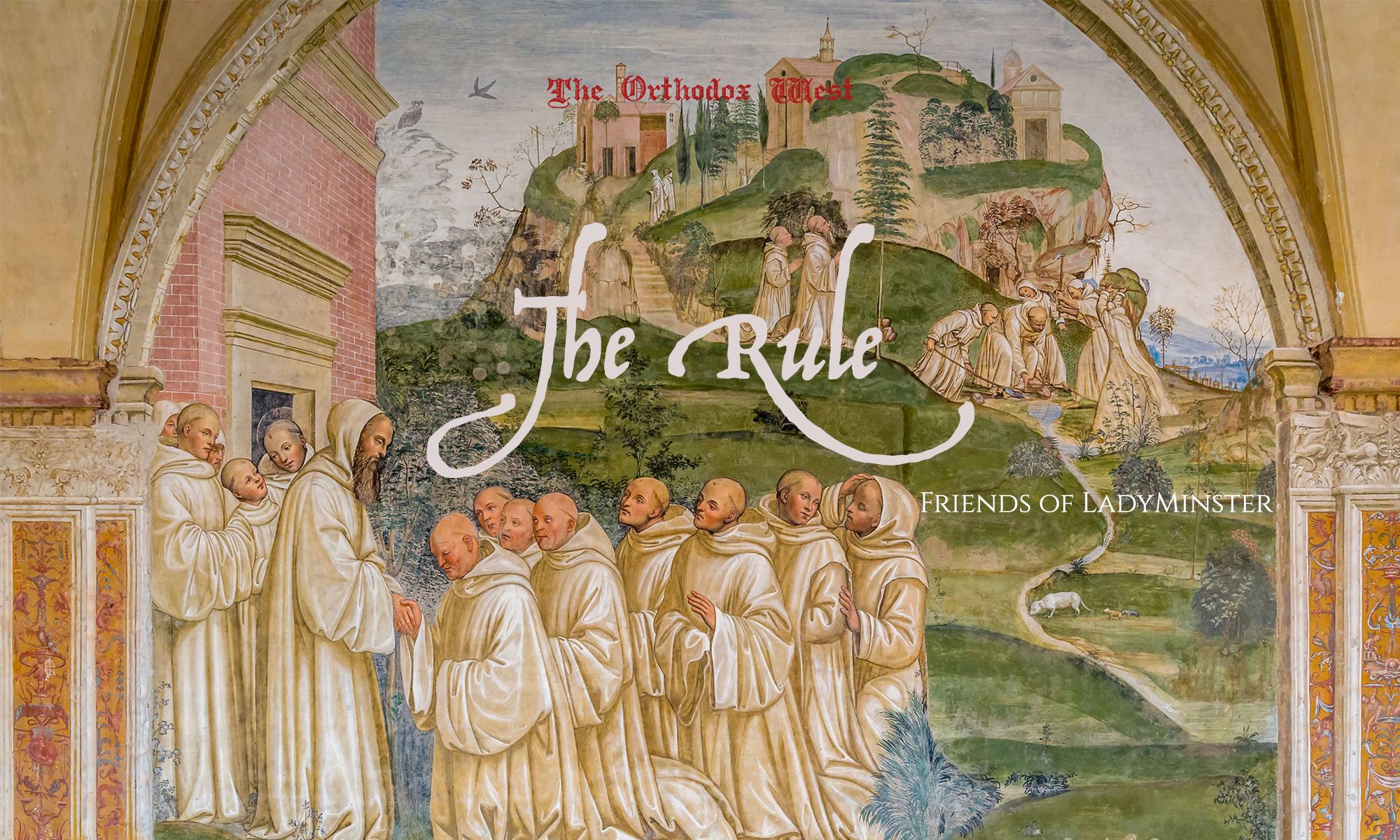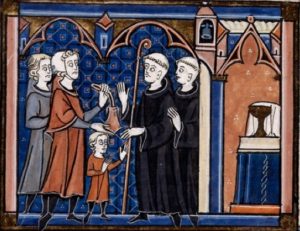My heart is fixed, O God, my heart is fixed!
Ps. 57:7 (Coverdale Psalter)
By the Rt. Rev. Abbot Theodore (Phillips)
The Benedictine monastic tradition is synthesized from the combined wisdom of both the great Eastern Fathers, through the mediation of Ss. Basil the Great and John Cassian, together with that of Ss. Ambrose, Augustine, Cæsarius, and other monastic founders or legislators in the West. In the spirit of all these worthy Fathers, however, its firm foundation is in the Holy Scriptures. St. Benedict himself points out, near the end of his famous Rule, “For what page or what utterance of the divinely-inspired books of the Old and the New Testament is not a most unerring rule of human life? Or what book of the holy Catholic Fathers is not manifestly devoted to teaching us the straight road to our Creator? Then the Conferences of Cassian and his Institutes, and the Lives of the Fathers, as also the Rule of our holy father Basil: what else are they but tools of virtue for good-living and obedient monks?”1
Many will ask, “I am not a monk or a nun, so what does this have to do with me?” Such a question is not limited to the faithful of Western Orthodox congregations; the same question arises among our brethren of the venerable Eastern Orthodox tradition. Out of their respect for Orthodox monastic life, many people tend to emphasize the differences between life in a monastery and life in secular society. It is true that, in some respects, monastic life is “harder” than life “in the world.” But it must also be said that in other respects, married life, is “harder” than life in the monastery. This is because both are faithful, honored modes of Christian life and are inherently ascetical vocations. In both, we must die to self and live for others; in both, we must learn the truth of what St. Paul wrote, “But God commendeth his love toward us, in that, while we were yet sinners, Christ died for us.”2 The Righteous One laid down his life for the unrighteous; the Giver of all good gifts laid down his life for those who were greedy, trapped in their selfish desires; Love Incarnate laid down his life for those full of hatred and bitterness.
In the centuries since St. Benedict wrote his Rule, growing numbers of those living out their Christian lives “in the world,” have found association with a monastery to be helpful in developing a structure of disciplines to support them in their struggle. In many places, this is informal: people frequent the services in a local monastery’s temple; they have a spiritual father or mother who guides them in developing their prayer lives and avoiding the many pitfalls put in our way by worldly living, pride, or the demons; they make periodic retreats at the monastery in search of the quietness and solitude they cannot easily find in the midst of jobs, family, and civic duties. In Eastern Orthodox tradition, this has usually remained an informal arrangement. In the Benedictine tradition as it developed before the Great Schism, such associations became more formal, often through what is called “oblation,”3 through which a man or woman commits to live under the guidance of the Rule and customs laid down by the abbot of a particular monastery.
While not responsible for living the Rule in the same degree as monks or nuns, oblates do study the Rule and read a portion every day, as part of their spiritual reading. They undertake to pray a portion of the Divine Office (known in the East as “the Hours), which St. Benedict called “the Work of God;” they are free to do either the approved Western forms of these service or the approved Eastern forms. They assist in support of the monastery, live as faithful members of a canonical, Orthodox parish of either Western or Eastern Rite, and enjoy certain privileges in relation to the monastic community. They are not monks or nuns, and wear no special garb; but they do make annual promises of “stability of heart,4 conversion in the spirit of the Rule of St. Benedict,5 and obedience.”6 Why? Because a healthy spiritual life is built upon a disciplined, stable life of worship, prayer, sacrifice, and testing of the spirits.7 As a medieval monk once said, “Anyone who takes himself for his own spiritual director is the disciple of a fool.” The guidance of the Rule, and of the abbot as its interpreter, and of an experienced mentor during the year of formation as a novice, can be of immense value for avoiding foolishness, excess, or delusion (prelest). Of course, there are other ways of doing this; but many have found and are finding the formation and practice of a Benedictine approach to life to be of great value.
Bearing this in mind, it is obvious that the oblate fellowship is neither primarily a social organization nor an auxiliary society; neither is it a club; rather, it is a body of people who have undertaken, with the blessing of the abbot, specific obligations in covenant with a specific monastic brotherhood. Becoming and remaining an oblate is dependent upon fulfilling those obligations. Through their spiritual affiliation with the monastery, oblates become its “extended family” and have a priority in available accommodations in the guest house. They are always welcome to consult with the abbot or other approved members of the monastic community.
There is a weekly, optional Zoom video conference for oblates, which includes study of various texts approved by the abbot, followed by Compline. In time, there may be more than one weekly opportunity for this modern form of community.
Where several oblates live within a reasonable distance or worship at the same parish, it is possible that the abbot might bless having a local Society of St. Benedict, consisting of the local oblates, novice oblates, and other interested persons. Some of these groups meet weekly, some monthly, some quarterly. Every year, there is an annual oblate retreat hosted by the monastery, which is free of charge to oblates (non-oblates may attend at a minimal charge).
At present, the Monastery of Our Lady and Saint Laurence has about 70 oblates (including oblate novices, in their year of discernment and formation). Their prayers and support are essential to our resident community; we seek to support them to whatever degree is possible for us. They bring us joy and they help spread awareness of the existence of our small, Western-rite monastery and its ministry of hospitality and retreats.
If you would like further information about the monastery or the oblates, please see our web site: Ladyminster. You may also send an email to StBenObl@gmail.com regarding the oblates, or to molslabbot@gmail.com regarding the monastery.
1 Rule, Chapter 73.
2 Romans 5:8
3 From the Latin, oblatus, or offering; this is the term from which we derive “oblations,” the word used to describe the bread and wine offered to God in the Sacred Liturgy, that they may become the Body and Blood of Christ.
4 This amounts to a promise to remain an oblate for the term of one’s promise, not just “drop” it when for one or another reason it is difficult or disagreeable: “my heart is fixéd, O God,” i.e. it is “stable,” committed to God, his Church, and one’s monastery of oblation.
5 This includes faithful study of Benedictine values and observances, commitment to the Divine Office which – since the time of the Apostles – has long been the official daily prayer of the Church (though its format obviously evolved overtime), and the willingness to order one’s life according to one’s Christianity, not one’s Christianity according to the other circumstances or components of one’s life.
6 Oblates owe obedience to the abbot regarding the terms and practices of their oblation, but not when it comes to their parish life, work, family, or other things not related to being an oblate. The abbot is not automatically an oblate’s confessor and is bound not to interfere with that relationship.
7 cf I John:4

